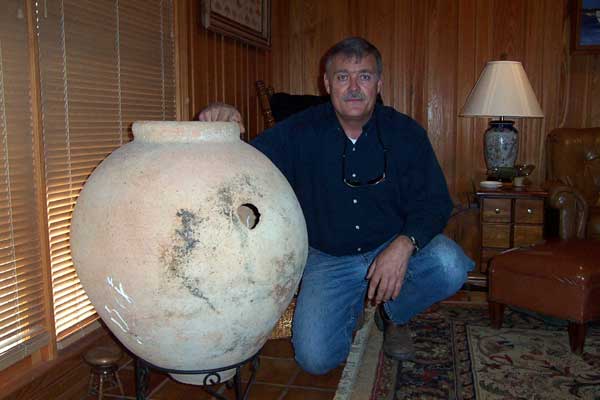|
Letters
Jugs recovered near St. Augustine Florida I have some fasinating pictures of some very large jugs. I would like to send you some pictures and see if you could help us identify them. They where caught in a shrimp net of the coast of St. Augustine. They are remarkable. Any info you could share would be very much appreciated. Let me know if it's alright to send you these photo's.
Mac.Gregory.
Hello again, Is St Augustine you refer to the one off the coast of Florida? and do you know the timing of the discovery of your olive jar which was picked up in a shrimp net? The shape of the one in your photo is totally different to the amphora found off the Balkan coast, those tended to be pointed at their base and also had two handles, given your jar was found off the US coastline, at this very early stage I will be looking for a Spanish vessel that was wrecked there many years ago. Whatever extra information you may be able to give me now would be most helpful. Regards, See this link about Olive Jars from the Jamestown Rediscovery site. Also that is St. Augustine, Florida. Sorry that I did not specify.
If we assume your picture is of Spanish origin, then the attached page is a description of various jars used to tranport Olive oil to America. There appear to have been three basic designs which are described here, Type B were globular in shape. Would you have any understanding how much oil might be held in your sample jar? There is a reference list at the end of the text here, and one entry would be worth while you trying to track down, I do not know you are located, but the following entry might prove fruitful: Markem, Mitchell. W. Pottery from Spanish Shipwrecks. University Press of Florida. Gaineville. 1994. Again, I am assuming the jar emanated from a Spanish shipwreck off St. Augustine, Florida. It is very difficult to pin down, I was hoping to find: ( a ) evidence of a Spanish shipwreck that was carrying olive oil from Spain to the New World, and ( b ) Some photos of actual oil jars so we might compare your jar with others. That might give a clue as to a date when it finished up on the sea floor. I am sorry I have not been very specific, but your quarry is elusive. In all these type of enquiries, one needs both sheer persistence, and then a little luck, the latter, thus far eludes me. I will be back, Regards,
Hello again, This photo is taken from the following site: http://dhr.dos.state.fl.us/ep/midship.html It is worth looking at. Also have a look at these sites: www.sfdj.com This one is a dive company with two books for sale. Vol 1 of GPS Adventures Galleon Hunter, and Vol 11 of GPS Adventures Reef Runner. There is no specific mention of Olive Jars on this site, but perhaps you should contact them at Knoxville to ascertain if they have found any such jars in their diving exploits. This site: http://www.virtualjamestown.org/images/artifacts/jamestown.html scroll down to Spanish Olive jar, after the text click on Large Image/Rotating image. You should no doubt talk to the appropriate people at Jamestown Rediscovery, they are active in the area of maritime history, and have some information about Spanish Olive Jars. They ought to be interested in your great speciman. I must acknowledge that my Grand daughter Amelia, with her friend Emily, aka the blond-goddess, produced these sites after my appeal for help. It does seem that my first assumption that your jar was of Spanish origin and is in fact an Olive Jar is probably correct. Many Shipwrecks off the Florida coast would be of Spanish origin, and of course this type of jar was used for many purposes, not just to contain oil. Do you know the location of the discovery of the jar you sent the photo of? and when it was found? Is it a recent recovery? or have you had it for some time? The discovery site is the best clue to being able to pin it to a specific Spanish shipwreck, but without some more detail it is like looking for the proverbial needle in a hay stack, but in this case our haystack may be the vast ocean off Florida, or even farther afield. I hope these few notes may prove of interest. Best wishes,
|

